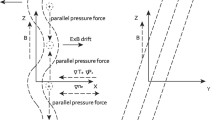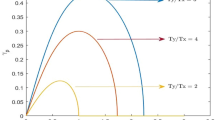Abstract
An investigation of the ion acoustic nonlinear periodic (cnoidal) waves in a magnetized plasma with positive ions having anisotropic thermal pressure and Maxwellian electrons is carried out. The Korteweg-de Vries equation for the wave potential is derived via a reductive perturbation technique and its cnoidal wave solution is obtained. The effect of various relevant plasma parameters like ion pressure anisotropy and obliqueness of field on the characteristics of ion acoustic nonlinear periodic wave structures is investigated in detail. The present investigation could be useful in space and astrophysical plasma systems having ion pressure anisotropy, particularly, in the magnetosphere and near Earth magnetosheath.






Similar content being viewed by others
References
Adnan, M., Mahmood, S., Qamar, A.: Contrib. Plasma Phys. 54, 724 (2014a)
Adnan, M., Williams, G., Qamar, A., Mahmood, S., Kourakis, I.: Eur. Phys. J. D 68, 247 (2014b)
Baumjohann, W., Treumann, R.A.: Basic Space Plasma Physics. Imperial College Press, London (1997)
Bittencourt, J.A.: Fundamentals of Plasma Physics. Springer, New York (2004)
Chew, G.F., Goldberger, M.L., Low, F.E.: Proc. R. Soc. Lond. A 236, 112 (1956)
Choi, C.R., Ryu, C-Mo., Lee, D.Y., Lee, N.C., Kim, Y.H.: Phys. Lett. A 364, 297 (2007)
Denton, R.E., Anderson, B.J., Gary, S.P., Fuselier, S.A.: J. Geophys. Res. 99, 11 (1994)
Ichikawa, Y.H.: Phys. Scr. 20, 296 (1979)
Kaladze, T., Mahmood, S.: Phys. Plasmas 21, 032306 (2014)
Kaladze, T., Mahmood, S., Ur-Rehman, H.: Phys. Scr. 86, 035506 (2012)
Kauschke, U., Schlüter, H.: Plasma Phys. Control. Fusion 33, 1309 (1991)
Khater, A.H., Hassan, M.M., Temsah, R.S.: J. Phys. Soc. Jpn. 74, 1431 (2005)
Konno, K., Mitsuhashi, T., Ichikawa, Y.H.: J. Phys. Soc. Jpn. 46, 1907 (1979)
Manesh, M., Sijo, S., Anu, V., Sreekala, G., Neethu, T.W., Savithri, D.E., Venugopal, C.: Phys. Plasmas 24, 062905 (2017)
Parks, G.K.: Physics of Space Plasmas. Perseus, New York (1991)
Prudskikh, V.V.: Plasma Phys. Rep. 38, 545 (2012)
Prudskikh, V.V.: Plasma Phys. Rep. 40, 459 (2014)
Seough, J., Yoon, P.H., Kim, K., Lee, D.: Phys. Rev. Lett. 110, 071103 (2013)
Singh, K., Ghai, Y., Kaur, N., Saini, N.S.: Eur. Phys. J. D 72, 160 (2018)
Tiwari, R.S., Jain, S.L., Chawla, J.K.: Phys. Plasmas 14, 022106 (2007)
Ur-Rehman, H., Mahmood, S.: Astrophys. Space Sci. 361, 292 (2016)
Ur-Rehman, H., Mahmood, S., Hussain, S.: Phys. Plasmas 24, 012106 (2017)
Ur-Rehman, H., Mahmood, S., Kaladze, T., Hussain, S.: AIP Adv. 8, 015311 (2018)
Yadav, L.L., Sayal, V.K.: Phys. Plasmas 16, 113703 (2009)
Yadav, L.L., Tiwari, R.S., Sharma, S.R.: J. Plasma Phys. 51, 355 (1994)
Acknowledgements
Authors gratefully acknowledge the constructive suggestions of an anonymous referee which significantly improved the quality of the manuscript. Ata ur Rahman would like to thank Dr. Fazli Hadi for his support and assistance.
Author information
Authors and Affiliations
Corresponding author
Additional information
Publisher’s Note
Springer Nature remains neutral with regard to jurisdictional claims in published maps and institutional affiliations.
Appendix: Derivation of Eqs. (9)–(11) from Eq. (2) using Eq. (3)
Appendix: Derivation of Eqs. (9)–(11) from Eq. (2) using Eq. (3)
We consider the ion momentum equation (2), repeated below:
We also know from Eq. (3) that the anisotropic pressure is
where \(\hat{I}\) and \(\hat{b}\hat{b}\) in matrix form can be written as,
The divergence of pressure tensor becomes
Note that \(\vec{\nabla }\cdot ( p_{\perp }\hat{I} ) = \vec{\nabla }p_{\perp }\). Further we may also write Eq. (48) in the following form
From Eq. (4), we know that
Using Eq. (50) into Eq. (49), we get
We plug the above value of \(\vec{\nabla }\cdot \tilde{P}\) into Eq. (46), and finally arrive at the set of Eqs. (9)–(11).
Rights and permissions
About this article
Cite this article
Khalid, M., Rahman, Au. Ion acoustic cnoidal waves in a magnetized plasma in the presence of ion pressure anisotropy. Astrophys Space Sci 364, 28 (2019). https://doi.org/10.1007/s10509-019-3517-0
Received:
Accepted:
Published:
DOI: https://doi.org/10.1007/s10509-019-3517-0




